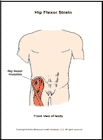
Hip Flexor Strain
What is a hip flexor strain?
A strain is a stretch or tear of a muscle or tendon, a band of tissue that connects muscle to bone. The tendon may be inflamed. Inflammation of a tendon is called tendonitis. The hip flexor muscles allow you to lift your knee and bend at the waist.
How does it occur?
Hip flexor strain occurs from overuse of the muscles that help you flex your knee or do high kicks. This injury occurs in bicyclists, athletes who jump or run with high knee kicks, athletes like soccer players who do forceful kicking activities, and people who practice the martial arts.
What are the symptoms?
You have pain in the upper groin region where the thigh meets the pelvis.
How is it diagnosed?
Your health care provider will examine your hip and thigh. You will have tenderness at the muscle and tendon.
How is it treated?
Treatment may include:
- putting ice packs on the injured area for 20 to 30 minutes every 3 to 4 hours for 2 to 3 days or until the pain goes away
- taking anti-inflammatory medications prescribed by your health care provider
- doing rehabilitation exercises to help you return to your activity.
While you are recovering from your injury, you will need to change your sport or activity to one that does not make your condition worse. For example, you may need to swim instead of bicycling or running.
When can I return to my sport or activity?
The goal of rehabilitation is to return you to your sport or activity as soon as is safely possible. If you return too soon you may worsen your injury, which could lead to permanent damage. Everyone recovers from injury at a different rate. Return to your sport or activity will be determined by how soon your hip flexor muscles recover, not by how many days or weeks it has been since your injury occurred. In general, the longer you have symptoms before you start treatment, the longer it will take to get better.
You may safely return to your sport or activity when, starting from the top of the list and progressing to the end, each of the following is true:
- You have full range of motion in the leg on the injured side compared to the leg on the uninjured side.
- You have full strength of the leg on the injured side compared to the leg on the uninjured side.
- You can jog straight ahead without pain or limping.
- You can sprint straight ahead without pain or limping.
- You can do 45-degree cuts, first at half-speed, then at full-speed.
- You can do 20-yard figures-of-eight, first at half-speed, then at full-speed.
- You can do 90-degree cuts, first at half-speed, then at full-speed.
- You can do 10-yard figures-of-eight, first at half-speed, then at full-speed.
- You can jump on both legs without pain and you can jump on the leg on the injured side without pain.
How can I prevent a hip flexor strain?
Hip flexor strains are best prevented by warming up properly and doing stretching exercises before your activity. If you are a bicyclist make sure your seat is raised to the proper height.

